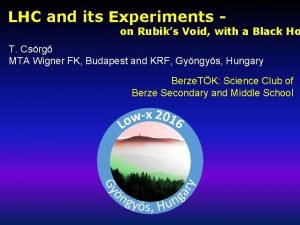Search for ray Emission from RadioQuiet Seyfert AGN

- Slides: 1

Search for γ-ray Emission from Radio-Quiet Seyfert AGN Masaaki Hayashida (KIPAC/SLAC and Kyoto Univ. ) <mahaya@slac. stanford. edu>, Keith Bechtol (SLAC/KIPAC), Lukasz Stawarz (ISAS/JAXA), and Greg Madejski (KIPAC/SLAC) on behalf of the Fermi Large Area Telescope Collaboration Abstract In contrast to radio galaxies with luminous relativistic jets, radio emission from Seyferts is generally weak, usually dominated by diffuse emission of the interstellar medium. Low-power radio-emitting outflows have been resolved in some Seyferts, but little is known about their γ-ray properties. We report results from a systematic investigation of Seyfert AGN at Me. V-Ge. V photon energies, utilizing two years of Fermi-LAT data, and a uniform sample of objects selected from the Swift-BAT 58 -month catalog. Our preliminary results indicate that radio-quiet Seyferts are `γ-ray quiet' as a class of AGN. The derived upper limits in the Me. V-Ge. V range exclude g-ray emission from Seyfert nuclei exceeding 1% of their X-ray luminosities. selected Seyfert Galaxies Sample Selection Recent discoveries of γ-ray emission from non-blazar AGN by Fermi-LAT raise the question: Are there galaxies capable of producing strong g-ray emission without luminous relativistic jets and/or starburst activity? Hard X-ray observations are used to select a complete and unbiased sample of Seyfert galaxies because hard X-ray emission is a clear and common signature of AGN activity. The galaxies are selected on a basis of the Swift-BAT 58 month catalog [2]. In order to extract `radio-quiet’ objects, we defined `hard X-ray radio loudness’ as follows: Obvious candidates might be AGNs generally devoid of prominent jets, e. g. Seyfert galaxies, identified in the optical regime as AGN hosted by late-type galaxies with bright unresolved nuclei. Seyferts are also bright in X-rays, and both the optical and the X-ray emission components are produced by matter accreting onto supermassive black holes. Figure 1. Schematic diagram of optical to X-ray emission ingredients in radio-quiet AGN powered by accretion onto supermassive back holes. Taken from [1]. LAT Data Analysis and Results Analysis Parameters • Observation times: August 4, 2008 - August 4, 2010 • IRF: P 6_V 11_DIFFUSE • Photon events: 0. 2 -100 Ge. V, `diffuse’ class • Source fitting model: power law -> d. F/d. E = N(E/E 0)-G The 1. 4 GHz radio fluxes are gathered from catalogs such as NVSS, FIRST and PKSCAT 90. Figure 2. Distribution of ‘hard X-ray radio loudness’ parameter for Seyfert galaxies (both radio-quiet and radio-loud, yellow), and comparison sample of beamed AGN (known as radio-loud, blue). Summary of Selection Criteria (120 total objects in sample) • Hard X-ray fluxes [n. Fn]14 -195 ke. V > 2. 5 x 10 -11 [erg/cm 2/s] in Swift-BAT catalog • Spectral classification as `galaxies' or `Seyfert galaxies' in Swift-BAT catalog • Hard X-ray radio loudness parameter Rrx < 10 -4 (selects radio-quiet objects) - This happens to exclude two Seyferts with high star-forming rate, NGC 1068 and NGC 4945 • Galactic coordinates |b| > 20 o for -20 o < l < 20 o, and |b| > 10 o otherwise Results ( • No significant excess is found positionally coincident with any Seyfert galaxies in the sample • 95 % upper limits (UL) calculated with a fixed photon index G=2. 5 in a range of 0. 1 -10 Ge. V are presented • Mean value of the UL: ~ 5 x 10 -9 ph cm-2 s-1 Comparison with EGRET Results • (0. 5 – 1. 5)x 10 -7 ph cm-2 s-1 (individual sources) [3] • (0. 3 – 1. 5)x 10 -8 ph cm-2 s-1 (stacking with brighest 32 Seyferts)[4] Figure 3. Histogram of g-ray photon flux upper limits (95 % C. L. ) for the analyzed Seyfert galaxies. Multi-wavelength Comparison Discussion of Emission Models We compare hard X-ray (14 -195 ke. V) emission measured with Swift-BAT to derived ULs for γ-ray energy flux and luminosity. Ge. V emission from Seyferts is excluded to the level of Lg/LX < 0. 1 for most sources, and < 0. 01 for several sources. Since hard X-ray luminosity is expected to constitute about 10% of the bolometric AGNrelated luminosity, LAGN, of a typical Seyfert galaxy [5], the Ge. V emission probed in our analysis reaches Lg/LAGN < 0. 001 in several examples. . Implications on g-ray emission models from Seyfert galaxies based on our results of g-ray upper limits : Ø Any jet-related g-ray emission components in radio-quiet AGNs, if present, is not prominent. Ø Gamma rays from Seyferts could originate from a disk coronae involving a non-thermal electron population [e. g. , 6, 7]. However, the non-thermal power-law tails in the Me. V range should not constitute more than ~ 10 % of total energy radiation in the X-ray regime. Ø Ge. V photons from Seyferts could also be generated through proton-proton interactions in the innermost parts of accretion disks [e. g. , 8]. In the case of a maximally spinning black hole, some models predict that hadronic emission in the 0. 1 -10 Ge. V range could reach > 10 % of the disk/disk corona X-ray luminosity, but we did find any such signal in our analysis. Figure 4. Hard X-ray (14 -195 ke. V) versus UL for the γ-ray (0. 1 -10 Me. V) for the analyzed sample of Seyferts. Dotted lines denote the ratios between g-ray and hard X-ray emission of 1, 0. 1, and 0. 01, respectively. Left: energy flux. Right: luminosity. All points represent g-ray upper limits Conclusions ü Radio-quiet Seyfert galaxies are generally g-ray quiet as a class of AGNs (0. 2 -100 Ge. V) ü Upper limits in the Me. V-Ge. V domain exclude the presence of g-ray emission in Seyfert nuclei exceeding 1% of the X-ray luminosities ü Me. V-Ge. V emission detected so far by Fermi-LAT from a few radio-quiet Seyfert galaxies (NGC 1068, NGC 4945, both well-known starburst galaxies) may be attributed to cosmic-ray induced emission in the interstellar medium of host galaxies References [1] Mushotzky et al. 1993, ARA&A, 31, 717 [2] http: //heasarc. gsfc. nasa. gov/docs/swift/results/bs 58 mon/ [3] Lin et al. 1993, Ap. JL, 416, L 53 [4] Cillis et al. 2004, Ap. J, 601, 142 [5] Ho 2008, ARA&A, 46, 475 [6] Zdziarski & Lightman 1985, Ap. JL, 294, L 79 [7] Inoue, Totani & Ueda 2008, Ap. JL, 672, L 5 [8] Niedzwiecki, Xie & Zdziarski 2009, The Extreme Sky: Sampling the Universe above 10 ke. V

